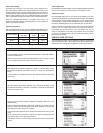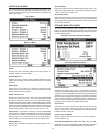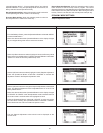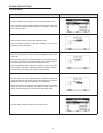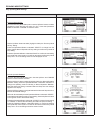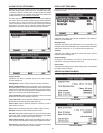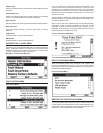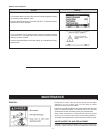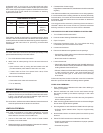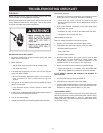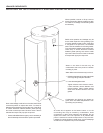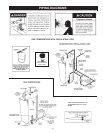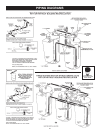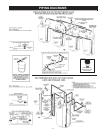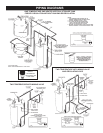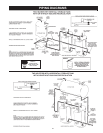
32
its diameter is 3/8” (1 cm) of an inch, or annually which ever is rst.
Aggressive, very hot and softened water causes rapid consumption
of the anode requiring frequent inspections. Call the toll free number
on the back cover of this manual for information on obtaining
replacement anode rods.
MAINTENANCE SCHEDULE
Component Operation Interval Required
Tank Flushing Periodically
Elements Lime Scale
Removal
As needed Un•Lime
®
delimer &
element
gaskets, Part
Tank ushing should be performed in accordance with the above
schedule. Tank sediment removal and element lime scale removal
must be performed as needed as determined by periodic inspection.
Following are the instructions for performing recommended
maintenance.
FLUSHING
The water heater drain valve should be opened periodically to help
prevent sediment buildup on the tank bottom.
1. Turn off the electrical disconnect switch.
2. Attach hose to outlet opening of drain valve and direct end
to drain.
• Open the drain valve by turning the hand wheel to the left
(counterclockwise). Allow water to ow until it runs clean.
• If water does not flow from opened drain valve, follow
instructions for sediment removal.
3. When nished ushing:
• Close heater drain valve and remove hose.
• Turn on electricity.
SEDIMENT REMOVAL
Water borne impurities consist of ne particles of soil and sand which
settle out and form a layer of sediment on the bottom of the tank.
In time, if not removed, the level of sediment might reach the
heating elements and cause their failure.
For convenience, sediment removal and element lime scale removal
should be performed at the same time as follows.
LIME SCALE REMOVAL
Lime scale accumulations on the heating elements is a normal
condition, common to all immersion type elements. Factors
which affect the amounts of this formation are:
1. Amount of hot water used. As the volume of water heated
increases, more scale results.
2. Water temperature. As the temperature of the water is increased,
more scale is deposited on the elements.
3. Characteristics of water supply.
Regardless of water treatment, the elements should be examined
regularly.
Lime scale accumulations may cause noises to occur during operation.
It is recommended that a heating element be removed periodically
for examination. If it is scaled, all of the elements should be removed
and cleaned. If the tank bottom has an accumulation of sediment it
should be cleaned.
Lime scale should be removed by dissolving the accumulation in
UN•LIME
®
delimer. Do not use muriatic or hydrochloric acid base
deliming solutions to remove lime scale from the elements.
THEPROCESSFORLIMESCALEREMOVALISASFOLLOWS:
1. Turn off electrical disconnect switch.
2. Drain the heater following DRAINING instructions.
3. Open front panel.
4. Disconnect the element wiring. Try not to disturb the wiring
unnecessarily and reconnection will be easier.
5. Unscrew each element.
6. Remove the elements and gaskets from the openings.
• Use a twisting, pulling action to remove elements scaled beyond
the size of the tank openings.
• Brush loose scale from elements.
7. Lime scale removal:
• Place limed ends of heating elements into UN•LIME delimer and
allow scale to dissolve. Do not permit delimer or water to contact
heating element electrical terminals.
• Silicates, sulfates, and aluminates must be removed by scraping
or other mechanical means. Lime scale dissolvents will
not remove these types of scale which are occasionally
encountered.
Call the toll free phone number on the back cover of this Instruction
Manual to purchase UN-LIME and heating element gaskets.
OTHERSCALEREMOVAL:
1. Flush cleaned ends of elements with water when deliming or
cleaning is completed.
2. Remove sediment and scale from the tank bottom through
the access provided by the element openings or drain valve
opening.
• The cold water inlet valve and drain valve may be opened to
aid the cleanout process.
3. Clean remaining gasket material from tank and element anges
Do not reuse original element gaskets.
4. Put new gaskets on each element and install into tank openings.
• Uniformly tighten element bolts. Torque to approximately
32 ft./lbs.
5. Attach element wires to connection points from which they were
removed.
6. Follow FILLING instructions to restore hot water service.
• Check for water leaks around elements and proper operation
when heater is lled.
• Close the front panel.



